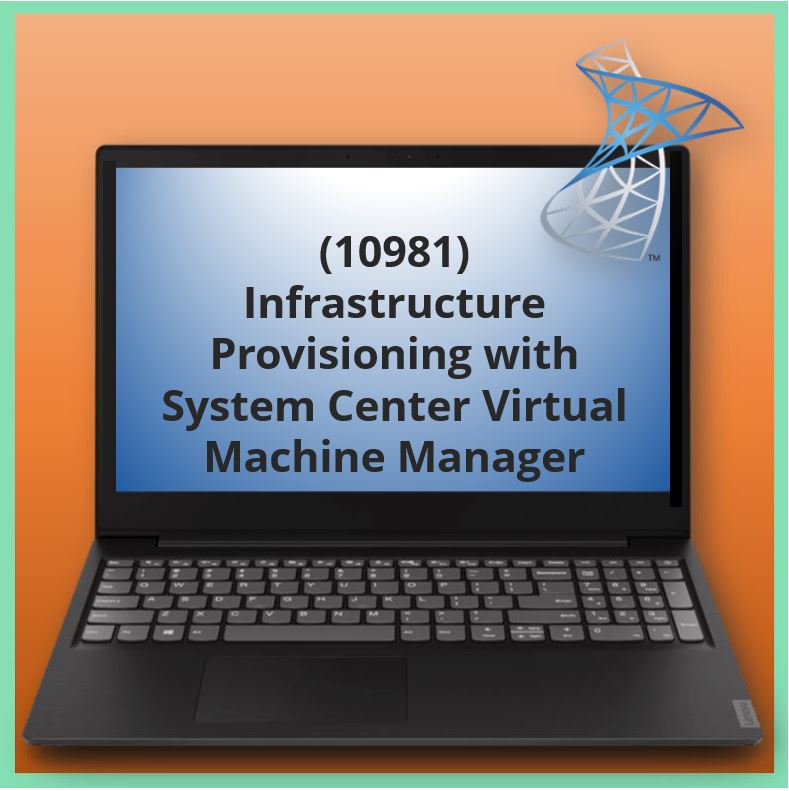Aangeboden leervormen

Infrastructure Provisioning with System Center Virtual Machine Manager (10981)
About this Course
Learn how to install and configure Microsoft System Center 2012 R2 Virtual Machine Manager and manage enterprise datacenter resources with this five-day course. This course is part two in a series of two courses that provides the skills and knowledge necessary to implement an enterprise virtualization solution. This course will cover implementing, managing, maintaining and provisioning services and infrastructure in a Windows Server 2012 and Windows Server 2012 R2 environment using System Center 2012 R2 Virtual Machine Manager. Although there is some cross-over of skills and tasks across these courses, this course primarily covers the advanced and enterprise-level technologies and solutions available through Microsoft virtualization, networking and storage. Using hand-on labs, students will learn the following:
• New features and capabilities in Windows Server 2012 R2 Hyper-V and System Center 2012 R2 Virtual Machine Manager.
• How to configure High Availability for Hyper-V and Virtual Machine Manager.
• How to update the Virtual Machine Manager environment and underlying Fabric infrastructure including considerations for other System Center components.
• How to configure advanced networking features in Virtual Machine Manager such as Uplink Port Profiles and Virtual Port Profiles.
• How to configure Storage in Virtual Machine Manager including the advantages and disadvantages between different storage types.
• How to manage clouds in Virtual Machine Manager including configuring cloud resources and provisioning access to a cloud.
• How to configure and manage the Library in Virtual Machine Manager including Library synchronization and equivalence objects.
• How to prepare the Windows Operating System for deployment in Virtual Machine Manager including how to use Sysprep, WIM and an unattend.xml file.
• How to configure and use Virtual Machine Templates and Service Templates in Virtual Machine Manager including how Service Templates are used in a real-world scenario.
• How Virtual Machine Manager integrates with other System Center components such as Operations Manager and Orchestrator including how Operations Manager monitors the Virtual Machine Manager environment.
• An overview of Windows Azure Pack including how to complete an express deployment and how to configure VM Clouds.
• How to configure Azure Site Recovery to replicate and recover virtual machines.
At Course Completion
After completing this course, students will be able to:
· Perform initial configuration tasks in Virtual Machine Manager including:
· Review and prepare the Hyper-V environment for Virtual Machine Manager
· Add Hyper-V Hosts to Virtual Machine Manager
· Configuring Host Groups
· Use Virtual Machine Manager PowerShell Cmdlets
· Configure High Availability for Hyper-V and Virtual Machine Manager including:
· Reviewing Distributed Key Management
· Configuring SQL AlwaysOn
· Clustering Hyper-V Hosts
· Configuring High Availability for the management Virtual Machines
· Update the Virtual Machine Manager environment including:
· How to update Virtual Machine Manager
· Configuring and using Baselines to update the Virtual Machine Manager infrastructure
· Configure advanced networking in Virtual Machine Manager including:
· Creating Logical Networks
· Creating Uplink and Virtual Port Profiles
· Creating and deploying Logical Switches
· Creating VM Networks
· Configure Storage in Virtual Machine Manager including:
· Discovering, classifying, creating and allocating storage
· Configure the Virtual Machine Manager Library and Library objects including:
· Creating Library Servers
· Enabling de-duplication
· Adding Library Servers to VMM
· Synchronizing Libraries
· Prepare a Windows Server Operating system for deployment including:
· Using Sysprep
· Using an Unattent.xml file
· Converting a WIM to VHDx
· Configuring bare-metal deployments of Hyper-V and Scale-out file servers
· Configure Virtual Machine and Service Templates including:
· Creating Hardware Profiles
· Creating Guest OS Profiles
· Importing and configuring Service Templates
· Configure System Center Integration including:
· Configuring integration with Operations Manager
· Configuring integration with Orchestrator
· Using Operations Manager to troubleshoot problems detected in Virtual Machine Manager
· Perform an express deployment of Windows Azure Pack including:
· Configuring a VM Cloud
· Configuring User Accounts
· Configuring Plans
· Deploying a Virtual Machine
· Configure Azure Site Recovery including:
· Configuring replication to Azure
· Recovering a virtual machine from Azure
Voor wie
This course is intended for IT Professionals who are responsible for designing, implementing, managing and maintaining a virtualization infrastructure or are interested in learning about current Microsoft Virtualization technologies for enterprise datacenter environments. This course is also intended for IT Decision Makers who will be determining which virtualization and infrastructure management products to implement in their datacenters.
Programma
Module 1: Overview of Hyper-V and Virtual Machine Manager
Before Virtual Machine Manager can be used to manage the virtualized environment you should understand some of the key concepts and features in both Hyper-V and Virtual Machine Manager. This includes the various networking and storage features in Virtual Machine Manger and how Virtual Machine Manager User Roles and Run As Account can be used to control access to the resources being managed. You should also understand how you can use Windows PowerShell with Virtual Machine Manager and how you can generate PowerShell Cmdlets for many tasks in the Virtual Machine Manager Console.
Lessons
· Overview of Hyper-V
· Overview of Virtual Machine Manager
Lab : Completing the Fabric for the VMM environment
· Reviewing the Hyper-V environment
· Adding Hyper-V Hosts to Virtual Machine Manager
After completing this module, students will be able to:
· Describe the key components and features in Hyper-V.
· Describe the key components and features in Virtual Machine Manager.
Module 2: Configuring High Availability for Virtual Machine Manager and Hyper-V
In most enterprise virtualized environments high availability is a key function that is implemented for business-critical workloads. This ensures workloads remain available at all times and also provides load-balancing capabilities. For this reason it is important that you understand how high availability can be configured for the Hyper-V Hosts, Virtual Machine Manager Management Server and the Virtual Machine Manager database. In this module you will learn about the clustering requirements for Virtual Machine Manager. You will also learn how to configure SQL AlwaysOn for the Virtual Machine Manager database. Finally, you will learn how to configure clustering for Hyper-V.
Lessons
· Clustering requirements for Virtual Machine Manager
· Configuring SQL AlwaysOn for the Virtual Machine Manager database
· Clustering the Hyper-V Hosts
Lab : Configuring High Availability for Virtual Machine Manager and Hyper-V
· Reviewing Distributed Key Management
· Configuring SQL AlwaysOn
· Clustering the Hyper-V Hosts
· Making the Management VMs highly available
After completing this module, students will be able to:
· Describe the clustering requirements Virtual Machine Manager.
· Configure SQL AlwaysOn for the Virtual Machine Manager database.
· Configure Hyper-V clustering.
Module 3: Updating Virtual Machine Manager and Fabric Servers
Keeping the IT environment up to date in an enterprise is paramount from both a security and a performance perspective. Proper update management also helps ensure that systems remain available by applying patches that improve the applications running on them. In the virtualized environment update management is just as important, especially when there are multiple System Center components deployed. In this module you will learn how Virtual Machine Manager integrates with Windows Server Update Services to manage the updates on Virtual Machine Manager Fabric infrastructure servers such as the Virtual Machine Manager Management Server and Library Server. You will also learn the considerations that should be taken into account and service order that should be applied when updating Virtual Machine Manager when you have other System Center components deployed.
Lessons
· Understanding the Servicing Order for System Center
· Performing the manual update process in Virtual Machine Manager
· Patching the Virtual Machine Manager Fabric with Windows Server Update Services
Lab : Updating the Virtual Machine Manager environment
· Updating Virtual Machine Manager
· Patching the Virtual Machine Manager Fabric Servers
After completing this module, students will be able to:
· Describe the servicing order when updating System Center components.
· Update Virtual Machine Manager.
· Update the Virtual Machine Manager Fabric.
Module 4: Configuring Networking in Virtual Machine Manager
Networking in Virtual Machine Manager has been extended extensively within the last two iterations of System Center. For example, in System Center 2012 SP1 Virtual Machine Manager, the ability to deploy third-party switch extensions such as Cisco was added. In System Center 2012 R2 Virtual Machine Manager, Top-of-rack (TOR) switch integration was added. It is important that you not only understand the basic concepts of networking in Virtual Machine Manager but that you also know how to configure some of the advanced network settings. This knowledge will prove invaluable when configuring Virtual Machine Manager in an enterprise environment, especially where networking spans multiples sites and/or locations. In this module you will learn some of the key networking fundamentals in Virtual Machine Manager before moving onto advanced networking features such as Port Profiles, Top-of-rack switches and Windows Server Gateways.
Lessons
· Overview of Networking in Virtual Machine Manager
· Logical Networks
· Uplink and Virtual Port Profiles
· Logical Switches
· Virtual Machine Networks
· Software Defined Networking (optional)
Lab : Configuring Networking in VMM
· Creating Logical Networks
· Creating Uplink and Virtual Port Profiles
· Creating and deploying Logical Switches
· Creating VM Networks
After completing this module, students will be able to:
· Describe the core networking features in Virtual Machine Manager.
· Create logical networks, network sites and IP pools.
· Configure Uplink Port Profiles and Virtual Port Profiles.
· Configure Logical Switches.
· Configure VM Networks.
· Understand Software Defined Networking in Virtual Machine Manager (optional).
Module 5: Configuring Storage in Virtual Machine Manager
Virtual Machine Manager provides support for both Block Storage and File Storage. Block Storage can include Fibre Channel, iSCSI and Serial Attached SCSI (SAS). File storage includes network file shares that can be located on a Windows File Server or on third party Network Attached Storage (NAS) devices provided by vendors such as NetApp or EMC. When configuring storage in Virtual Machine Manager you need to understand how it is discovered, classified, provisioned, allocated and decommissioned. In this module you will learn about the various storage options that are available in Hyper-V and Virtual Machine Manager. You will also learn how storage is discovered and classified. Finally, you will learn how to configure and manage storage in Virtual Machine Manager.
Lessons
· Storage options available in Hyper-V and Virtual Machine Manager
· Understanding Storage in Virtual Machine Manager
· What Storage will be managed?
· Configuring and Managing Storage in Virtual Machine Manager
Lab : Provisioning and configuring Storage in Virtual Machine Manager
· Creating the iSCSI Target
· Discovering Storage in Virtual Machine Manager
· Classifying Storage in Virtual Machine Manager
· Allocating Storage in Virtual Machine Manager
After completing this module, students will be able to:
· Describe the storage options available in Virtual Machine Manager.
· Understand storage in Virtual Machine Manager.
· Understand what storage will be managed in Virtual Machine Manager.
· Configure and manage storage in Virtual Machine Manager.
Module 6: Managing Clouds in Virtual Machine Manager
One of Virtual Machine Managers most powerful features is its ability to create and manage Private Clouds including the resources made available to them and controlling access to Virtual Machines and Services deployed within them. Before provisioning a Private Cloud in Virtual Machine Manager it is important that you understand the key concepts around Cloud Computing such the difference between Private, Public and Hybrid Clouds. When provisioning a Private Cloud it is also important that you configure the resources available to the cloud appropriately. This includes the Library resources, Virtual Machines and Services that are deployed to the cloud. In this module you will learn some of the key concepts in Cloud computing. You will also learn how to create and manage a Private Cloud in Virtual Machine Manager including how resources, capacity and capability are configured for the cloud. Finally, you will learn how access to the Private Cloud and its associated resources is configured.
Lessons
· Introduction to Clouds
· Creating and Managing a Private Cloud in Virtual Machine Manager
· Working with User Roles in Virtual Machine Manager
Lab : Managing Clouds in Virtual Machine Manager
· Creating Private Clouds using the Virtual Machine Manager Console
· Creating Private Clouds using PowerShell
· Creating User Roles
· Assigning Permissions to Users
After completing this module, students will be able to:
· Describe the key concepts in Cloud Computing.
· Create and manage Clouds in Virtual Machine Manager.
· Create and configure User Roles in Virtual Machine Manager.
Module 7: Configuring and Managing the Virtual Machine Manager Library and Library Objects
The Virtual Machine Manager Library provides access to file-based resources such as sysprep images, virtual hard disks and ISO files. This makes provisioning Virtual Machines and Services much quicker and easier as the Library acts as a catalog of resources that are available at all times. It is important that you understand how to configure and manage the Virtual Machine Manager Library especially when you have multiple Library servers in your environment. In this module you will learn about the Virtual Machine Manager Library structure and how Libraries are synchronized. You will also learn about equivalence objects with the Library and how library objects can be tagged and versioned.
Lessons
· Overview of the Virtual Machine Manager Library
· Managing Libraries
Lab : Configuring and Managing the Virtual Machine Manager Library
· Creating a Library Server
· Creating the Library Share and enabling de-duplication
· Adding the Library Server to Virtual Machine Manager
· Creating a secondary Library Server and synchronizing Libraries
After completing this module, students will be able to:
· Describe the Virtual Machine Manager Library.
· Configure and manager the Virtual Machine Manager Library.
Module 8: Preparing the Windows Operating System for deployment in Virtual Machine Manager
There are a number of methods that can be used to prepare an Operating System for deployment in Virtual Machine Manager. For example, you can use Sysprep to prepare an Operating System which then generalizes the image so that it can be re-used indefinitely. You can also use a Windows Imaging Format (WIM) file to create a .VHD. It is important that you understand the various methods in which an Operating System can be prepared for deployment so that you can use the best method for your environment. In this module you will learn how to use Sysprep and WIM to prepare Operating System images for deployment with Virtual Machine Manager. You will also learn the architecture of virtual machines in relation to physical computers including how application settings are affected in a virtualized environment. Finally, you will learn about the preparations that must be performed when deploying bare-metal Hyper-V Hosts and Scale-out File Servers.
Lessons
· Preparing a Windows Operating System
· Virtual Machine Architecture
· Preparations required for Bare Metal deployments of Hyper-V and Scale-out File Servers
Lab : Preparing the Windows Operating System
· Using Sysprep
· Converting a WIM to VHDx
After completing this module, students will be able to:
· Prepare a Windows Operating System for deployment in Virtual Machine Manager.
· Understand Virtual Machine Architecture.
· Prepare for a bare-metal deployment of Hyper-V and Sale-out File Server.
Module 9: Virtual Machine and Service Templates
Templates in Virtual Machine Manager provide a method of standardizing the deployment of Virtual Machines and Services thereby saving time and ensuring that when deploying them, they are configured appropriately. When creating a Virtual Machine or Service Template there are many properties that can be configured such as the hardware, Operating System and applications that will be deployed, so it is important that you understand how these properties are configured. In addition, when creating Virtual Machine Templates you can also apply Hardware, Guest OS and Application Profiles which can be used to apply standard settings for Virtual Machines and Services deployed with Virtual Machine Manager. In this module you will learn how to configure Virtual Machine and Service Templates. You will also learn how to create hardware and Guest OS Profiles to help standardize the deployment of Virtual Machines and Services. You will also learn how to configure, deploy and update Service Templates including how Service Templates are used in the real world.
Lessons
· Overview of Virtual Machine Templates
· Overview of Service Templates
Lab : Deploying Virtual Machines and Services
· Creating an Unattend.xml file
· Creating a Hardware Profile
· Creating a Guest OS Profile
· Creating an Application Profile
· Creating a Virtual Machine Template
· Creating a Service Template
· Importing, configuring and deploying a Service Template
After completing this module, students will be able to:
· Configure Virtual Machine Templates.
· Configure Service Templates.
Module 10: System Center Integration
Virtual Machine Manager, as with other System Center components can be integrated with other components to provide additional features and manageability. For example when Virtual Machine Manager is integrated with Operations Manager you can monitor the Virtual Machine Manager environment and be alerted when Operations Manager detects problems such as a pending hard disk failure in the Virtual Machine Manager fabric. By integrating Virtual Machine Manager with Orchestrator you can also automate tasks in Virtual Machine Manager such as deploying a Virtual Machine or a Service. In this module you will learn how integration between Virtual Machine Manager and Operations Manager is configured and what benefits this brings. You will also learn how integration between Virtual Machine Manager and Orchestrator is configured including the benefits this brings.
Lessons
· Monitoring the Virtual Machine Manager environment with Operations Manager
· Automation with Orchestrator
Lab : Responding to Alerts using Orchestrator
· Using Operations Manager to detect memory utilization issues
· Changing the Alert Resolution State in Operations Manager and confirming that Orchestrator has increased available memory on the Virtual Machine
After completing this module, students will be able to:
· Monitor the Virtual Machine Manager environment with Operations Manager.
· Automate the Virtual Machine Manager environment with Orchestrator.
Module 11: Windows Azure Pack
Windows Azure Pack is a no-cost Azure solution for the datacenter. By using Windows Azure Pack and Virtual Machine Manager you can offer cloud-based services such as Virtual Machine Clouds, Web Site Clouds and SQL Server databases from a secure Self-Service environment hosted in your datacenter. In this module you will learn about the key features of Windows Azure Pack including its architecture and the Tenant and Administrator Portals that provide access to the Windows Azure Pack features. You will also learn about the various deployment methods for Windows Azure Pack including how to perform an express deployment. Finally, you will learn how to configure VM Clouds, User Accounts and Plans in Windows Azure Pack so that you can offer Self-Service Virtual Machine provisioning.
Lessons
· Overview of Windows Azure Pack
· Deploying Windows Azure Pack
· Configuring Windows Azure Pack
Lab : Deploying Windows Azure Pack and provisioning infrastructure services
· Deploying Windows Azure Pack
· Configuring Windows Azure Pack
· Configuring a Virtual Machine Cloud
· Configuring User Accounts
· Configuring Plans
· Deploying a Virtual Machine
After completing this module, students will be able to:
· Describe Windows Azure Pack.
· Perform an Express deployment of Windows Azure Pack.
· Configure Windows Azure Pack.
Module 12: Azure Site Recovery
As with most business critical applications and services, a disaster recovery solution is key to ensure applications and services are available at all times. This is also the case in a virtualized environment. Microsoft Azure Site Recovery provides a service that can be used to orchestrate the replication, failover and recovery of an on-premise Virtual Machine Manager environment to another on-premise Virtual Machine Manager environment such as a disaster recovery site. In addition Azure Site Recovery can be used to replicate the Virtual Machine Manager environment to Azure. In this module you will learn how to configure Azure Site Recovery to provide protection for the Virtual Machine Manager environment including how it can be integrated with Windows Azure Pack to provide disaster recovery for IaaS workloads.
Lessons
· Overview of Azure Site Recovery
· Configuring and using Azure Site Recovery
Lab : Configuring Azure Site Recovery
· Configuring Azure Site Recovery
After completing this module, students will be able to:
· Understand Azure Site Recovery.
· Configure Azure Site Recovery.
Voorkennis
Before attending this course, students must have the following technical knowledge:
• Recommended: MCSA: Windows Server 2012.
• Recommended: Course 20409: Server Virtualization with Windows Server and System Center.
• An understanding of virtualization concepts and working knowledge of Microsoft Hyper-V.
• An understanding of TCP/IP and networking concepts and working knowledge of Microsoft networking.
• An understanding of different storage technologies and concepts and working knowledge of Microsoft storage technologies and solutions.
• Working knowledge of Windows PowerShell.
Examen
NVT
Duur training
Klassikaal: 4 dagen
Open Leercentrum: 5 dagen








